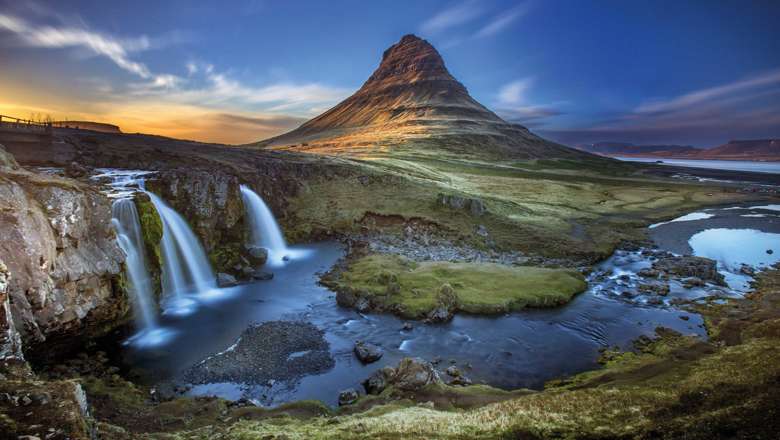Our guide to visiting Iceland
Iceland is an increasingly popular holiday destination, with huge numbers of tourists flocking to its mountainous beauty and rugged landscapes each year. At Jules Verne, we know that this small and underpopulated land is perfect for intrepid travellers searching for unique experiences. Indeed, its small size makes it perfectly possible to travel the length of the country in one tour.
Jules Verne and Iceland have a long-standing connection. The final destination in his classic novel, Journey to the Centre of the Earth, can be found here on the Snæfellsnes Peninsula. And so, today, we’re turning the spotlight onto Iceland. We’ll explain why we think this starkly beautiful country is a fascinating destination for anyone interested in rich cultural history, captivating landscapes, and natural phenomena.
The Landscapes of Iceland
Iceland is renowned for its breathtaking landscapes, created over the ages by an awe-inspiring natural history. Geologically, Iceland is a young island; it started growing out of the middle of the ocean around 20 million years ago. Its location on the Mid-Atlantic Ridge is still geologically active, as recent times have shown. Eyjafjallajökull, which caused travel disruptions in 2010, sits alongside many other volcanoes – Hekla, Herðubreið and Eldfell to name a few. The otherworldly landscapes they create are a photographer’s paradise.
There are plenty of other natural wonders to discover in Iceland. Many of the icefalls, fjords and valleys that exemplify the country’s geology can be explored on short trips from Reykjavik. In summer, venture deep into the seasonally inaccessible inlands to discover landscapes like no other.
Visit the spectacular Goðafoss waterfall, a huge arc of over 12 metres of foaming white water. Discover the craters of Skútustaðargígar, which have marked the Icelandic landscape since ancient times. View the Námaskarð bubbling mud pools, a sulfuric phenomenon that looks like an extra-terrestrial scene.
The abundant plant life makes Iceland the perfect place for amateur botanists to indulge in their hobby. The fauna too is a draw; whale watching is a popular part of any Iceland tour. Travellers also have the chance to see reindeer, arctic fox, and even the occasional polar bear, if they’re very lucky.
The History of Iceland
The first permanent settlers in Iceland are thought to have been a Norwegian chieftain and his wife, in around 870. However, archaeological evidence points to earlier visitors, including Irish monks and Norse sailors. Many others followed, and by the end of the 9th century, the country was occupied by Norwegian, Irish and Scottish settlers.
Although these settlers were largely pagan when they arrived, by the end of the 10th century the country was becoming more Christianised. None of the buildings remain from that era, but in the valley of Thingvellir you can see the Lögberg or "Law Rock", where laws and important decisions were made at the time, including the decision to switch to Christianity.
The eruption of Laki in 1783 resulted in the death of a quarter of the population. Many locals moved to the New World, and many of the older buildings were destroyed. Luckily for the modern visitor, the remains of Viking longhouses have been found in central Reykjavik, and can be seen today at the Settlement Exhibition.
One hundred years after the initial settlement, Denmark granted home rule to Iceland. The struggle for independence continued until 1945, when full autonomy was granted to the people. The newly established parliament took its place in the Althing, on the same Thingvellir ("Thing Fields") where meetings have been held since 930 AD.
The Culture of Iceland
Icelandic culture relies on a sense of community. There are many theories as to why this might be, but it is likely that the small population and relative isolation have resulted in tight-knit communities. Iceland is frequently cited as one of the best places to live, along with other Nordic countries. Visitors are sure to experience the communal living and generosity of spirit in the welcome they receive.
Part of this welcome is often the chance to try some tasty local delicacies. Although there are few vegetables on offer due to the challenging climate, the reliance on rich dairy products, fresh fish and meat means that local food is not lacking in flavour. Taste regional specialities such as skyr yoghurt, fresh black pudding, and, more exotically, cured shark.
For those who like a tipple, this latter treat is often served with Iceland’s signature beverage, Brennivín. It’s a type of vodka flavoured with botanicals. Beware though – this is not for the faint of spirit. There’s a reason locals call it Black Death.
Iceland has the highest number of book shops per capita in the world, all of which will stock Iceland’s best known works of literature, The Sagas of the Icelanders. These prose epics, set in Iceland’s age of settlement, were written during the so-called Saga Age in the 9th and10th centuries. Some of the original documents can still be seen in the Culture House in Reykjavík, which houses some of Iceland’s most treasured literary artefacts.
Music also plays an important part in local culture. One form of traditional music is Rimur, epic ballads based on medieval poems and performed acapella. Today, however, much of the Icelandic music known in the rest of the world is less traditional, with favourite exports including Of Monsters and Men, Sigur Ros and Björk.
Travelling in Iceland
The tourism industry has really taken off in Iceland since the financial crash of 2008. While it’s easy to see the benefits this has had on economic stability, it’s even easier to see why Iceland has become such a popular tourist destination.
One of the major draws are the Northern Lights. The spectacular phenomenon that is the Aurora Borealis cannot be described, although many have tried. Iceland is one of the best places to see them for yourself. Although the lights are illusive, visitors between September and March are most likely to catch them.
Reykjavik is worthy of a trip in and of itself, with its stunning coastal views and city life. The numerous bars and restaurants have a jovial atmosphere, and some, such as The Pearl, are world renowned for their stunning architecture.
There are plenty of architectural delights to explore around the city, including the city hall that sits over the water. This building is a piece of modern art, making use of the natural landscapes, water, and plants. It makes sense that it is also home to frequent modern art exhibitions as well as a fascinating 3D map of the Reykjavik area.
Just outside Reykjavik lies the Blue Lagoon, one of Iceland’s most popular tourist attractions. It is a geothermal spa, with waters reaching between 37 and 39 °C. It is named after the beautiful milky blue colour of the water, caused by high mineral content. These minerals are good for skin health, but also just great for relaxing.
Our final tips
- If you’re hoping to see the Northern Lights, November – March is the best time to travel.
- During the summer months, you can enjoy close to 24 hours of daylight, so you might want to pack an eye mask if you’re a light sleeper.
- Whatever time of year you visit, we recommend bringing some sturdy footwear so you can explore off the beaten track.
Discover Iceland for yourself on one of our tours, or find more travel inspiration through other posts in our Jules Verne Travel Inspiration.


